The Hidden Mathematics of Software Maintenance: Why Your Codebase Stops Growing
Have you ever wondered why software projects start fast but inevitably slow to a crawl? Why adding more developers doesn’t always speed things up? Why some codebases seem to hit an invisible wall while others sustain growth for years?
The answer lies in mathematics—specifically, the same mathematical principles that govern population dynamics in ecology. Every software project has a carrying capacity: a maximum sustainable size determined by language choice, team structure, and maintenance practices. Understanding this hidden mathematics can transform how we build and scale software.
The Feature Factory Paradox
Every development team experiences this phenomenon: explosive initial growth followed by an inexorable slowdown. Features that once took days now require weeks. Simple changes cascade into complex refactors. The team works harder but delivers less.
This isn’t a failure of process or people—it’s mathematical inevitability. Software development follows the same logistic growth patterns found throughout nature, from bacterial colonies to forest ecosystems. The difference is that we can measure it, model it, and plan for it.
The Two Forces: Features vs. Maintenance
At the heart of software dynamics lies a fundamental tension between two competing forces:
- Feature Development: Adding new capabilities, building business value
- Maintenance Work: Fixing bugs, refactoring code, managing technical debt
Every developer-hour spent on maintenance is an hour not spent on features. But every feature added without proper maintenance creates compound interest on technical debt. This creates a mathematical relationship that determines your project’s ultimate fate.
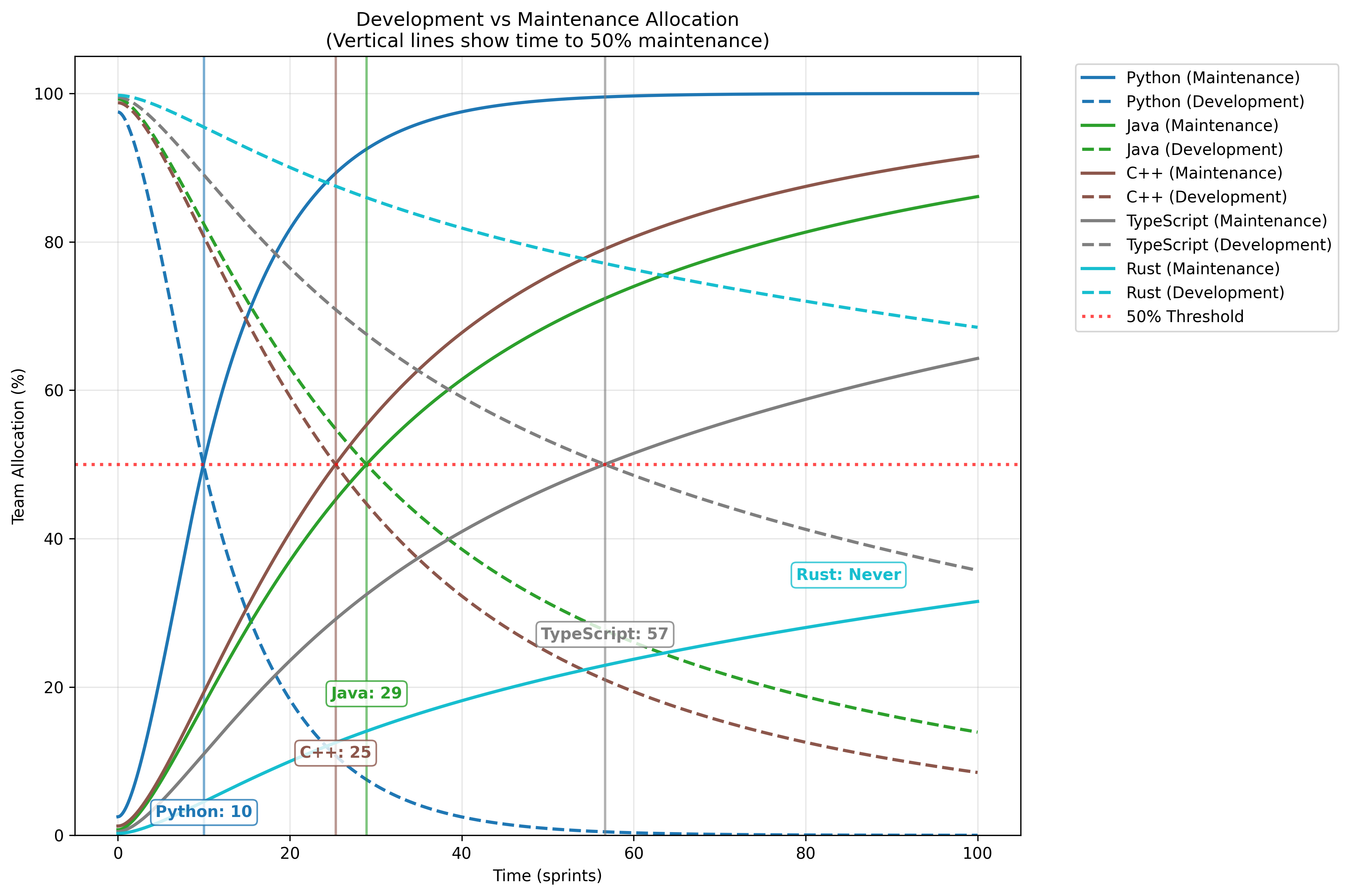
This visualization shows how different programming languages handle this tension over time. Notice the vertical lines—these mark when each language reaches the critical 50% maintenance threshold. Python hits this wall in just 10 sprints (~5 months), while Rust never reaches it at all.
The Carrying Capacity of Code
In ecology, carrying capacity represents the maximum population an environment can sustain. For software, it’s the maximum codebase size your team can maintain while still delivering features.
This capacity depends on several factors:
- Language maintainability: How much effort each line of code requires over time
- Development velocity: How quickly features can be initially implemented
- Team structure: Communication overhead and knowledge distribution
- Architectural decisions: Modularity, testing, and documentation practices
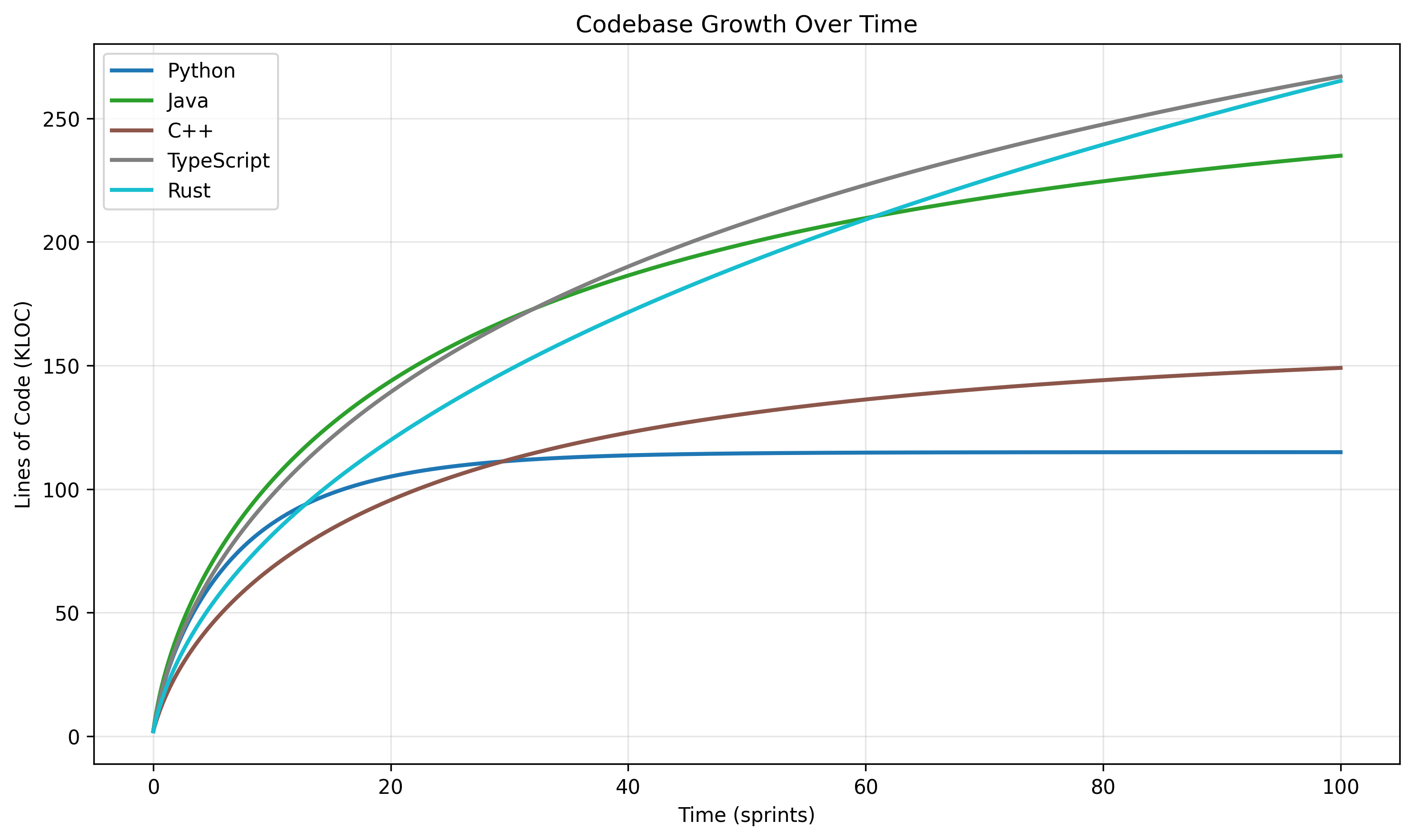
The mathematics is surprisingly predictable. Each language reaches a natural plateau where maintenance burden balances development capacity. Rust sustains the largest codebases (358 KLOC) while Python plateaus much earlier (114 KLOC).
The Mathematics Revealed
I’ve modeled software development as a system of coupled differential equations:
- L(t): Lines of code in thousands (KLOC)
- M(t): Maintenance hours required per sprint
The key insight is that maintenance grows with codebase size, eventually consuming all available development time:
dL/dt = (development_hours / total_hours) × dev_speed × complexity_factor
dM/dt = (required_maintenance - current_maintenance) × adjustment_rate
Where required_maintenance = L(t) × language.maintenance_burden
This simple model produces remarkably realistic behavior, capturing the exponential slowdown experienced by real development teams.
Language Design Matters—Mathematically
Different languages have vastly different maintenance characteristics. Here’s what the data reveals:
- Python: 10.0 hours/KLOC/sprint — High maintenance burden due to dynamic nature
- Java: 3.0 hours/KLOC/sprint — Enterprise overhead but reasonable maintainability
- TypeScript: 2.0 hours/KLOC/sprint — Type safety provides measurable advantage
- Rust: 1.0 hours/KLOC/sprint — Designed for long-term sustainability
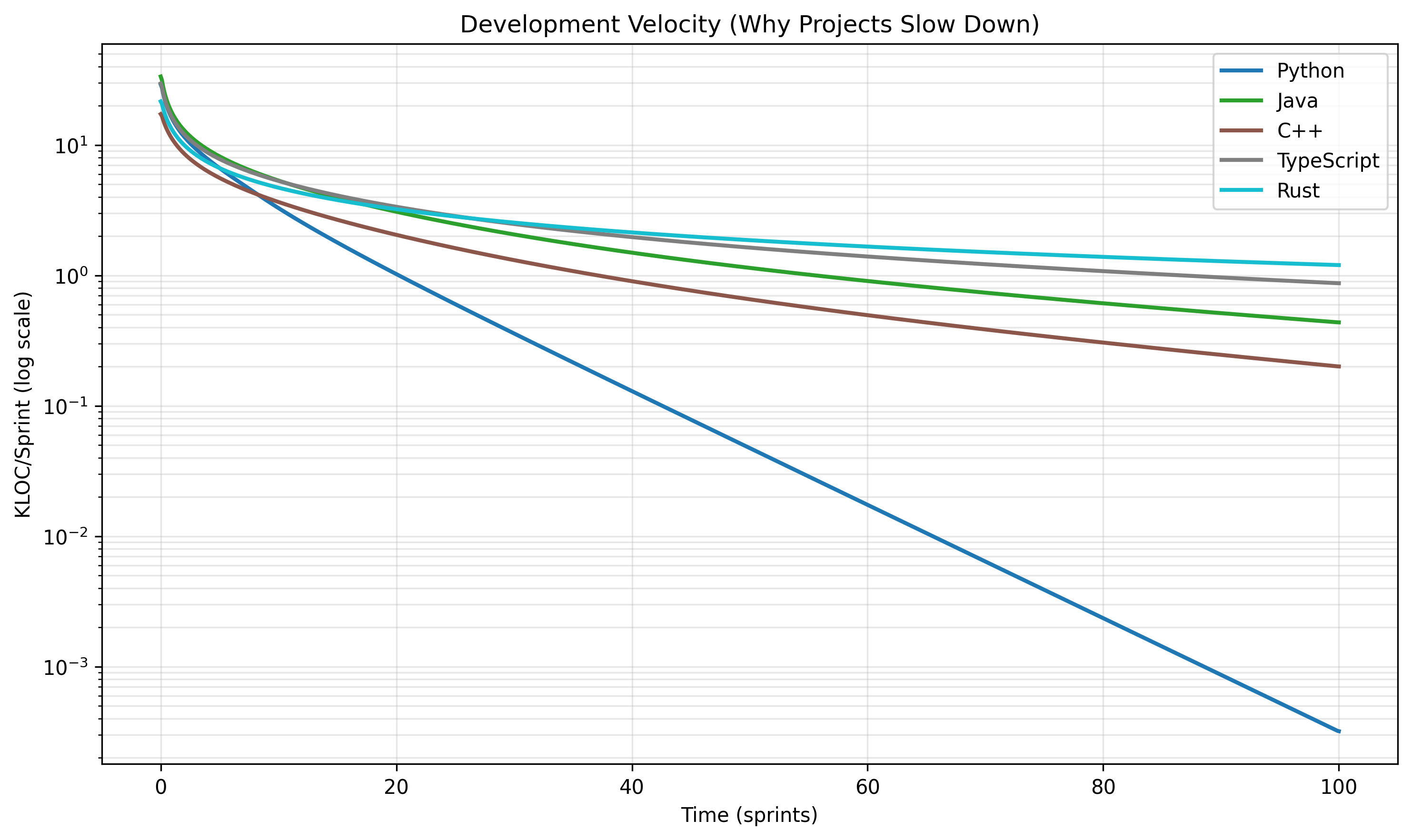
The log scale reveals the dramatic differences in velocity decay. Python’s exponential decline contrasts sharply with Rust’s sustained performance. This isn’t opinion—it’s mathematical fact derived from maintenance requirements.
The Maintenance Crisis Timeline
The most striking finding is how quickly projects hit the maintenance wall:
- Python: 10 sprints (~5 months) to 50% maintenance
- C++: 25 sprints (~1.3 years) to 50% maintenance
- Java: 29 sprints (~1.4 years) to 50% maintenance
- TypeScript: 57 sprints (~2.8 years) to 50% maintenance
- Rust: Never reaches 50% maintenance
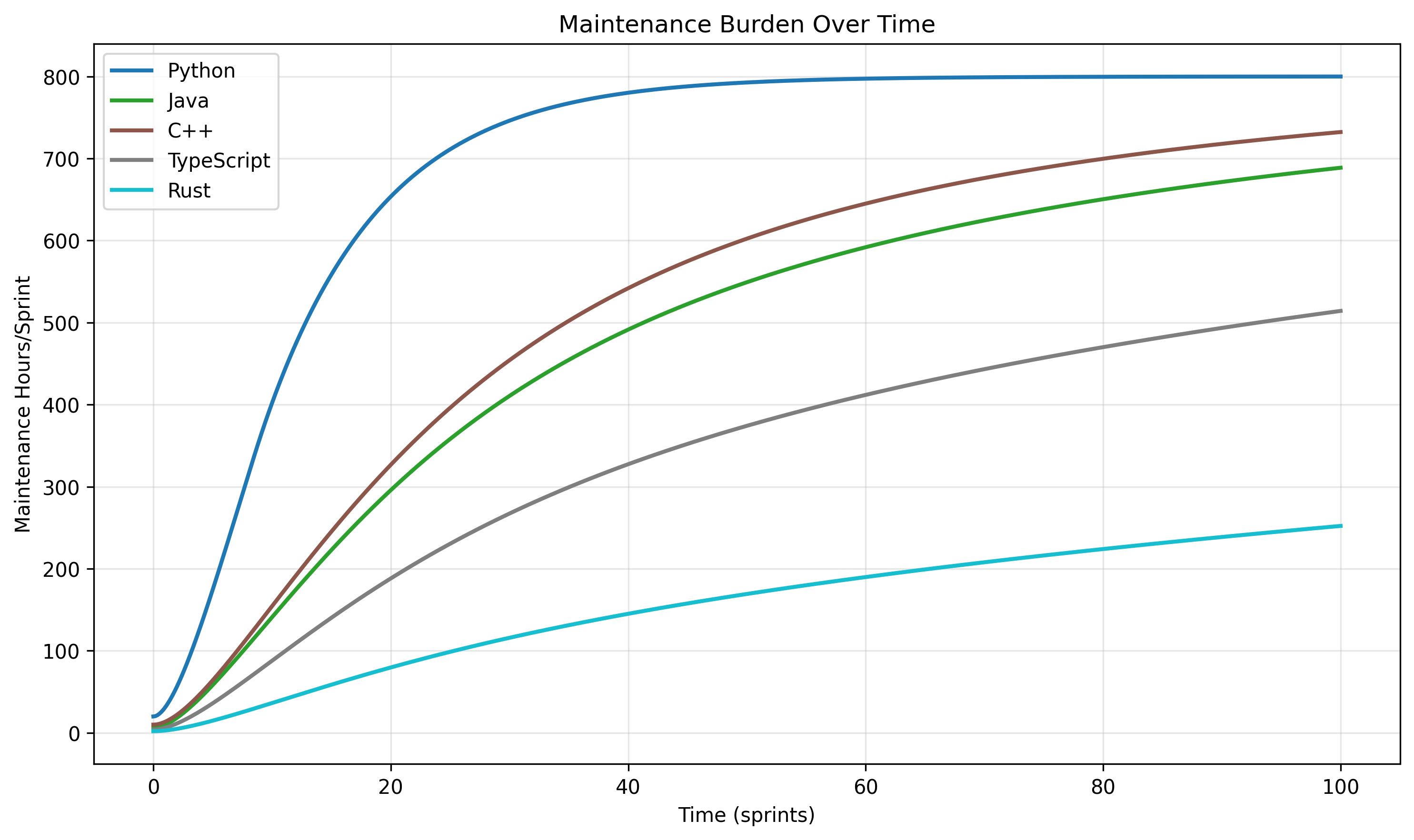
These aren’t arbitrary thresholds. At 50% maintenance allocation, teams spend more time fixing existing code than building new features. Beyond 80%, development effectively stops—teams enter “technical bankruptcy.”
Real-World Implications
For Engineering Managers
Set realistic expectations. Your velocity will decline mathematically. Plan for it rather than fighting it. Rust codebases can sustain growth 5x longer than Python codebases—factor this into technology decisions.
Resource allocation matters. The model shows optimal maintenance allocation varies by language. Fighting the mathematics by forcing “features-only” development accelerates the crisis.
For Developers
Language choice has compound effects. That “quick Python prototype” may become unmaintainable faster than you think. TypeScript provides measurable long-term advantages over JavaScript.
Write for maintainability from day one. The maintenance burden you create today determines your team’s velocity next year.
For Product Teams
Velocity naturally declines. This isn’t a team performance issue—it’s mathematical reality. Plan roadmaps accordingly.
Innovation requires sustainable pace. Features delivered quickly but unsustainably may actually slow long-term progress.
Feature Accumulation: The Business Perspective
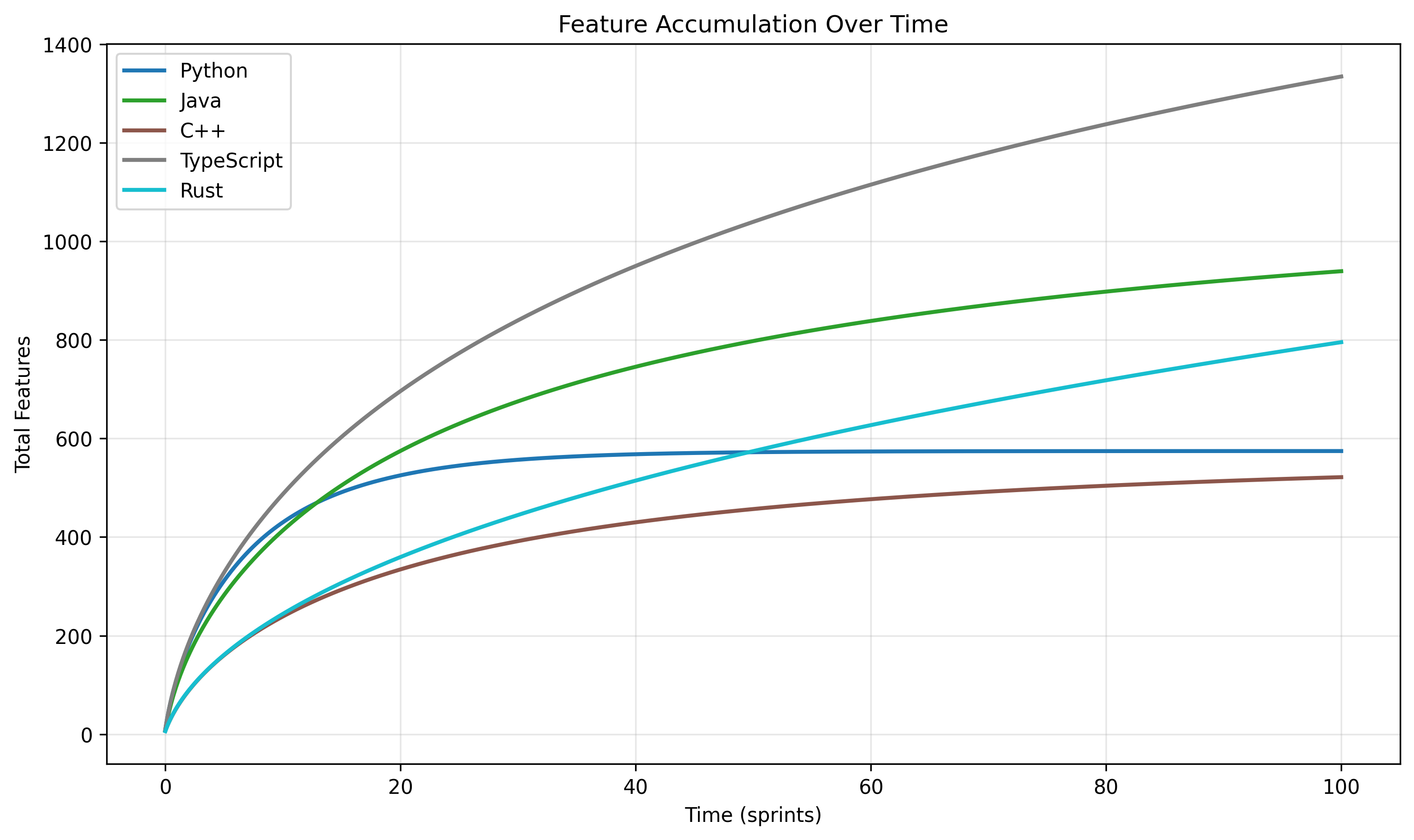
From a business perspective, what matters is total features delivered. TypeScript delivers 1,629 features sustainably, while Python manages only 572 before hitting its maintenance ceiling. The “faster” language actually delivers less value over time.
Breaking Through the Limits
While carrying capacity is mathematically inevitable, it’s not fixed. You can expand your limits through:
Architectural Innovation: Microservices, modularization, and clear interfaces reduce maintenance burden per line of code.
Tooling and Automation: AI-assisted development, comprehensive testing, and automated refactoring can shift the maintenance curve.
Language Evolution: Modern languages like Rust represent paradigm shifts toward sustainability, designed with carrying capacity in mind.
Strategic Technical Debt Management: Understanding the mathematical model helps optimize the features vs. maintenance trade-off.
Embracing the Mathematics
Software development is a marathon, not a sprint. The teams and companies that understand this mathematics gain a crucial advantage:
- They choose technologies based on long-term sustainability, not short-term speed
- They plan for velocity decline and budget maintenance work accordingly
- They recognize when projects approach carrying capacity and act proactively
- They measure and model their own development dynamics
The Model in Practice
Want to analyze your own codebase? The mathematical model is available on GitHub along with all visualizations. Key metrics to track:
- Lines of code growth rate (dL/dt)
- Maintenance time percentage
- Feature velocity trends
- Time to 50% maintenance threshold
Understanding the hidden mathematics of software maintenance transforms how we think about development. It’s not about working harder—it’s about working within mathematical reality.
Your codebase will reach carrying capacity. The question is: will you be ready?
The complete mathematical model and all visualizations are available in the GitHub repository. The model uses realistic industry data and can be adapted to analyze your own projects.